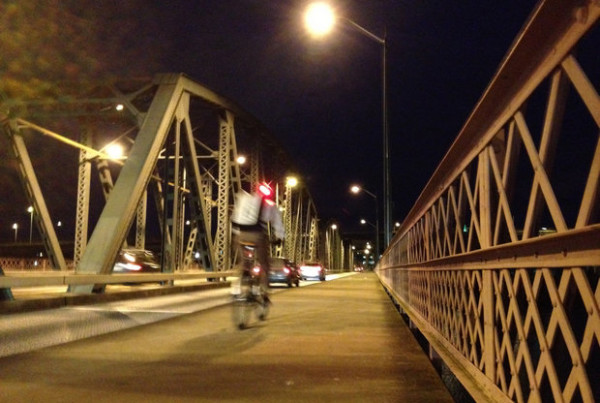The Christian Science Monitor: Can Bikes and Cars Share the Road?
An increase in the number of people commuting by bicycle instead of car would be an unqualified boon for the environment and for public health, but there don’t seem to be too many takers: According to 2005 US Census data, fewer than one half of one percent of Americans bike to work.
One of the biggest deterrents is the perception that cycling is unsafe. And no wonder: Pedaling down a public ways means placing yourself within a few feet of fast-moving one- or two-ton steel boxes, some of whose operators might be busy applying eyeliner, sending text messages, or both.
A survey by the fitness publisher Rodale Press (cited here in an article by the League of American bicyclists) found that some 40 percent of Americans would commute by bike “if safe facilities were available.” It seems that a lot more of us would like to bike to work, but we’re too afraid of the cars.
But how dangerous is cycling, exactly? In 2007, The New York Times’s Freakonomics blog cited a study by researchers John Pucher and Lewis Dijkstra that found that, per kilometer, those on bikes are 12 times more likely than those in cars to suffer a fatal accident.
It sounds scary, but it’s worth noting that the same study found that pedestrians are 23 times more likely than drivers to die, per kilometer. And it’s probably also worth pointing out – as Freakonomics did – this Danish study, which found that those who do not bike to work have a 39 percent higher mortality rate than those who do.
What’s more, according to an article on the legal website Nolo, only 11 percent of bicycle accidents involve a collision with a car. In most bicycle accidents, the cyclist simply loses control and crashes.
Still, collisions with cars tend to be the worst kinds of bicycling accidents, and cycling on American roads could certainly be safer. As Sightline Institute director Alan Durning noted in the environmental news website Grist, in another study the researchers Pucher and Dijkstra found that, per trip, American cyclists are twice as likely to be killed as German cyclists, and three times more likely to be killed as Dutch cyclists.
Part of the blame falls on bad drivers (it’s much harder to get licenses in Germany and the Netherlands). Most urban cyclists are keenly aware of such automotive assaults as the Right Hook (a car passes you and then makes a right turn directly in front of you), the Left Cross (they make a left turn right in front of you, or right into you), and the Door Prize (a car opens its door right in your path).
Then again, cyclists haven’t exactly earned themselves reputations as scrupulous law-abiders. In May, the New York Times reported that a study of cyclists in Midtown Manhattan observed more than two-thirds of cyclists running red lights.
Earlier this month, the Boston Globe’s David Filipov stood on a street corner in Boston – a city not known for its courtesy on the road – and observed cyclists blowing through red lights, riding against traffic, ignoring crosswalks, and riding on the sidewalk. His story, headlined “Boston’s unruly riders,” elicited almost 400 comments from drivers, cyclists, and pedestrians alike, many of them extremely angry at their fellow commuters.
In his Grist article, Sightline’s Alan Durning suggests that the widespread lawlessness among cyclists might be a result of the perception that cycling is dangerous. “The existing population of cyclists may be disproportionately made up of risk-takers,” he writes. “If everyone thinks biking is unsafe, the people who do it will be the ones who don’t mind danger.”
It could also be the laws themselves that put cyclists in danger. Indeed, bike lanes often put cyclists right in the paths of car doors, and waiting for a red light to turn green can get you right-hooked by cars. Many cycling advocates are pushing for states to adopt the Idaho stop law, which allows cyclists to treat red lights as stop signs, and stop signs as yield signs.
But it could also be the design of the roads themselves. A few years ago, the Livable Streets Initiative produced a video making the case for physically separated bike lanes. Perhaps an amicable split would be the best solution of all.

